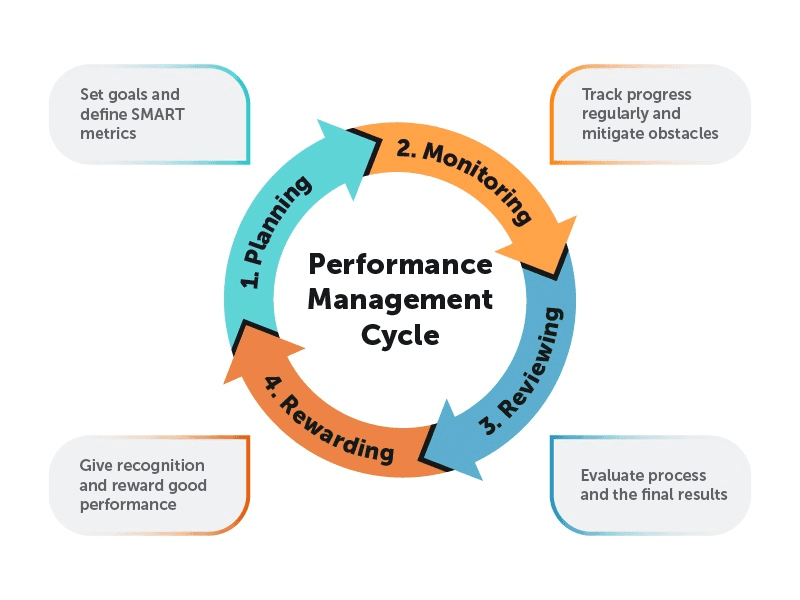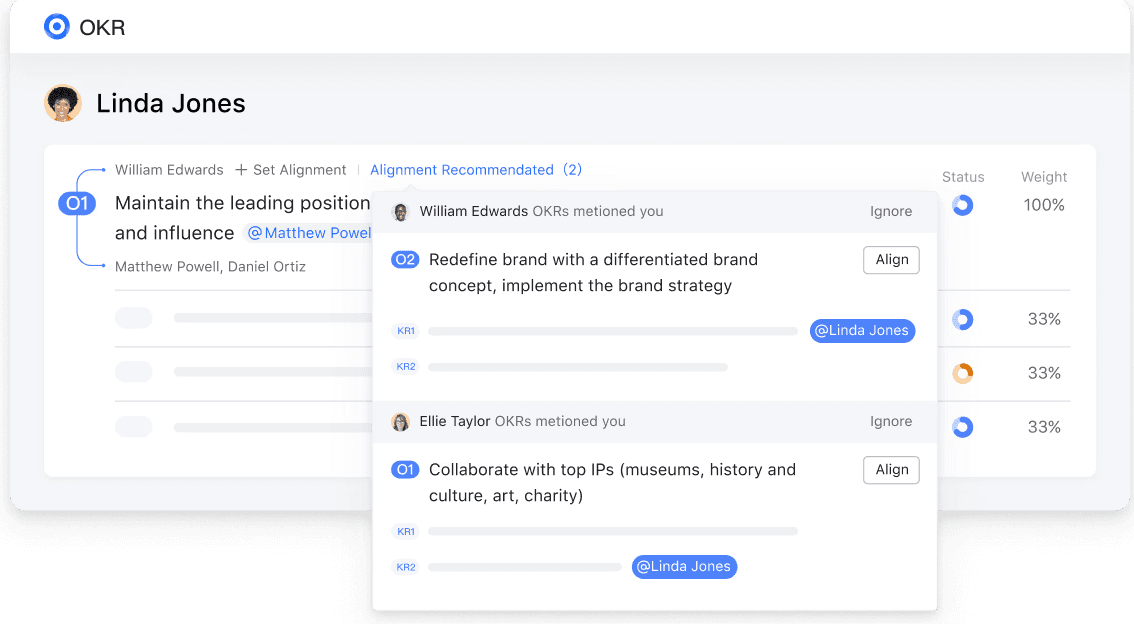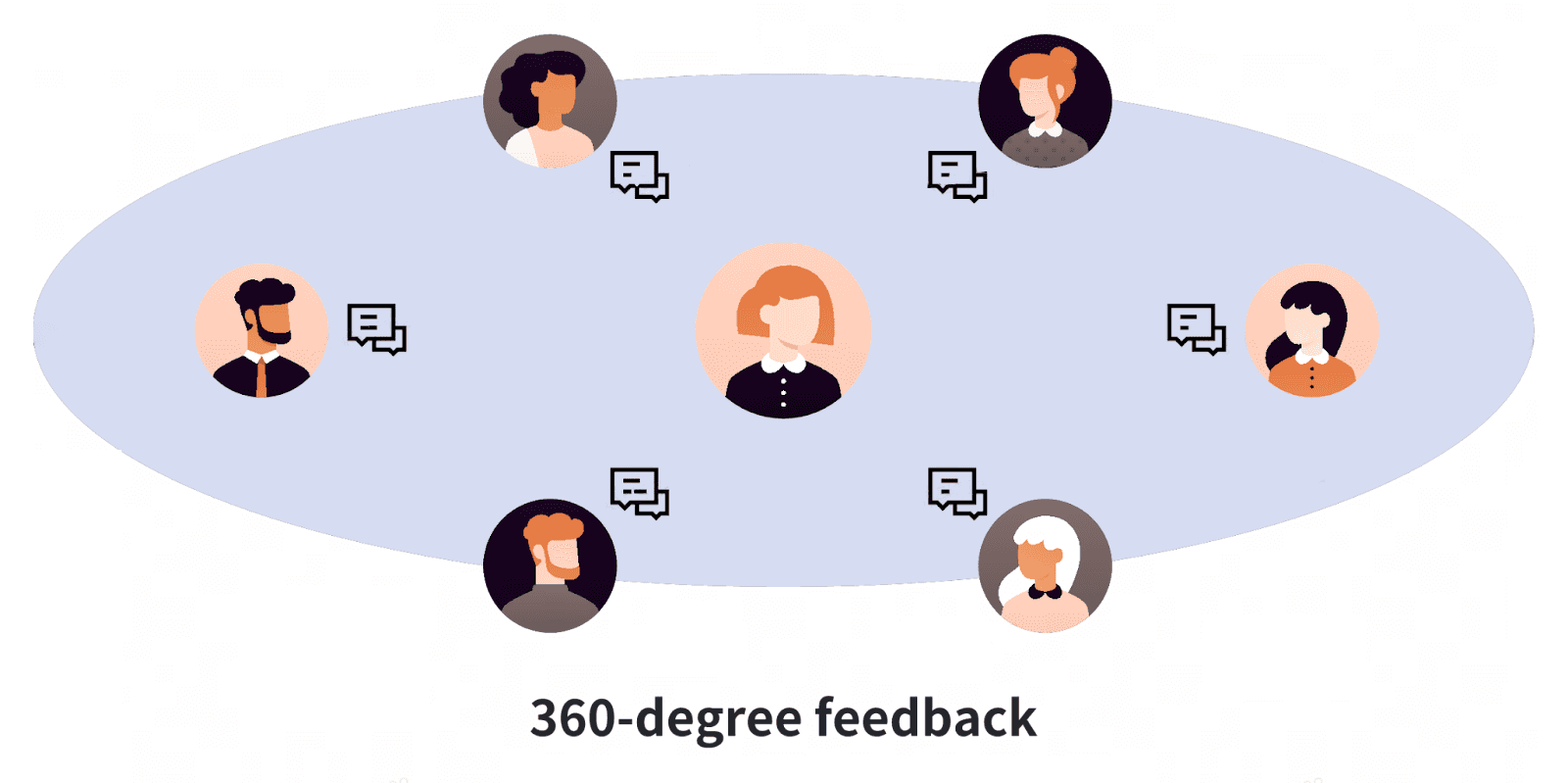Performance management is the backbone of any successful organization. Modern organizations are shifting toward real-time feedback, agile goal setting, and continuous improvement to keep up with dynamic market demands.
In this guide, we’ll explore the core principles, frameworks, and actionable strategies for effective performance management. Whether you’re an HR professional, a manager, or a business leader, this comprehensive guide will equip you with the tools to build a culture of high performance in your organization.
What is performance management
Performance management is a strategic process that ensures employees' efforts and contributions align with the overall goals of the organization. It goes beyond simply evaluating performance; it encompasses setting clear expectations, providing ongoing feedback, and fostering growth. At its core, performance management is about creating a partnership between employees and managers to drive continuous improvement, accountability, and engagement.
This process involves defining measurable objectives, monitoring progress, and recognizing achievements while addressing areas for development. Effective performance management not only boosts individual productivity but also strengthens team collaboration and organizational success. It’s a dynamic and iterative approach that adapts to changing business needs, ensuring employees remain motivated and aligned with the company’s vision.
Core principles of performance management
Effective performance management is built on a few key principles that ensure alignment, accountability, and employee growth:
1. Goal setting
Setting clear, actionable goals is the foundation of performance management. Using frameworks like SMART goals (Specific, Measurable, Achievable, Relevant, Time-bound) ensures that employees understand what’s expected of them and how their work contributes to the organization’s success.
For example, instead of setting a vague goal like “increase sales,” a SMART goal would be: “Increase monthly sales revenue by 15% by the end of Q2 through targeted email campaigns.”
2. Feedback and coaching
Feedback should be timely, constructive, and continuous. Employees thrive when they receive actionable insights on their performance. Coaching goes hand-in-hand with feedback, helping employees improve their skills and overcome challenges.
3. Employee development
Investing in employee growth is a win-win strategy. When employees feel supported in their career development, they’re more engaged and productive. This can include training programs, upskilling initiatives, and mentorship opportunities.
4. Recognition and rewards
Acknowledging achievements boosts morale and motivation. Recognition doesn’t always have to be monetary—publicly celebrating milestones, offering flexible work options, or providing growth opportunities can be equally impactful.
5. Performance tracking
Using measurable metrics and tools to track progress ensures accountability. Regularly reviewing performance data helps identify trends, address issues early, and celebrate successes.
The performance management cycle
The performance management cycle is a structured and continuous process designed to align employee efforts with organizational goals while fostering personal and professional growth. It’s not a one-time event but an ongoing framework that ensures accountability, engagement, and improvement. Let’s explore each stage in more detail:

Image source: valamis.com
1. Planning: Setting the foundation for success
The planning phase establishes clear expectations, measurable goals, and alignment between individual contributions and organizational priorities.
Goal Setting: Define clear, actionable objectives that align with organizational priorities.
Role Clarity: Ensure employees understand how their roles contribute to the organization’s success.
Collaborative Planning: Involve employees in setting goals to enhance ownership and motivation.
2. Monitoring: Keeping progress on track
Monitoring is an ongoing process that ensures employees remain focused and supported in achieving their goals.
Regular Check-Ins: Frequent discussions between managers and employees to track progress and address challenges.
Real-Time Feedback: Provide timely and constructive feedback to foster continuous improvement.
Performance Tracking Tools: Use technology to visualize progress and ensure accountability.
Coaching and Support: Offer guidance and resources to help employees overcome obstacles and grow.
3. Reviewing: Evaluating performance and identifying opportunities
The review phase evaluates employee performance and identifies areas for growth and improvement.
Structured Reviews: Conduct objective, data-driven evaluations to ensure fairness and transparency.
Feedback from Multiple Sources: Gather input to gain a comprehensive view of performance.
Development Discussions: Identify growth opportunities and align them with career aspirations.
4. Rewarding: Recognizing and reinforcing success
The final phase focuses on recognizing achievements and motivating employees to sustain high performance.
Tangible Rewards: Provide financial incentives or other concrete rewards for exceptional performance.
Non-Monetary Recognition: Highlight accomplishments through public acknowledgment or growth opportunities.
Celebrating Milestones: Recognize individual or team achievements to boost morale and camaraderie.
Creating a continuous feedback loop
Each phase of the performance management cycle informs the next, creating a continuous process of improvement and engagement.
Insights to Planning: Use review findings to refine future goals and strategies.
Adaptability: Adjust goals and strategies to reflect changing priorities or circumstances.
Employee Involvement: Actively involve employees in every stage to ensure engagement and effectiveness.
By embracing the performance management cycle as a dynamic process, organizations can drive sustained alignment, growth, and success.
Popular performance management methods and frameworks
There’s no one-size-fits-all approach to performance management. Organizations must select frameworks that align with their culture, goals, and workforce needs. Below are some of the most effective methods and frameworks that can help streamline performance management processes and drive success:
1. OKRs (Objectives and Key Results)
OKRs are widely used to align individual, team, and organizational objectives. This framework focuses on setting ambitious goals (Objectives) and defining measurable outcomes (Key Results) to track progress. OKRs are particularly effective for fostering transparency and ensuring everyone in the organization is working toward shared priorities.
Why it works: OKRs encourage focus, alignment, and accountability by breaking down large organizational goals into actionable steps.
Best for: Organizations looking to foster collaboration and achieve ambitious, measurable results.

Image source: larksuite.com
2. KPIs (Key Performance Indicators)
KPIs are specific, quantifiable metrics used to measure success in achieving operational or strategic objectives. Unlike OKRs, which are more aspirational, KPIs focus on tracking ongoing performance and ensuring teams meet established benchmarks.
Why it works: KPIs provide a clear way to monitor progress and identify areas that need improvement.
Best for: Tracking operational efficiency, customer satisfaction, or financial performance.
3. SMART goals
SMART (Specific, Measurable, Achievable, Relevant, Time-bound) goals provide a structured and clear approach to goal setting. This framework ensures that objectives are realistic and actionable, reducing ambiguity and enhancing focus.
Why it works: SMART goals promote clarity and accountability by providing employees with precise targets and deadlines.
Best for: Individual performance planning and short- to medium-term objectives.
4. MBO (Management by Objectives)
Management by Objectives emphasizes collaboration between employees and managers to set goals that align with organizational priorities. This method ensures employees understand how their contributions fit into the bigger picture and fosters a sense of ownership.
Why it works: MBO strengthens communication and alignment between employees and managers while promoting accountability.
Best for: Organizations seeking to create a shared sense of purpose and commitment to organizational goals.
5. 360-degree feedback
This method collects performance feedback from multiple sources, including peers, subordinates, and managers. It provides a well-rounded view of an employee’s strengths and areas for improvement.

Why it works: 360-degree feedback offers diverse perspectives, fostering self-awareness and encouraging personal growth.
Best for: Leadership development, team-based roles, and improving interpersonal dynamics.
6. Continuous feedback systems
Unlike traditional methods that rely on annual or bi-annual reviews, continuous feedback systems emphasize ongoing communication between employees and managers. These systems promote agility and allow organizations to adapt quickly to evolving needs.
Why it works: Continuous feedback helps employees stay aligned with goals, address challenges promptly, and improve performance in real time.
Best for: Dynamic environments where priorities shift frequently, such as tech or creative industries.
7. Balanced Scorecard
The Balanced Scorecard is a strategic performance management tool that evaluates organizational performance across multiple dimensions, such as financial, customer, internal processes, and learning and growth.
Why it works: It provides a holistic view of organizational performance, helping leaders balance short-term results with long-term strategy.
Best for: Organizations looking for a comprehensive framework to align strategy with day-to-day operations.
How to choose the right framework
Selecting the right performance management method depends on several factors:
Organizational goals: Are you focused on growth, efficiency, innovation, or employee engagement?
Company culture: Does your culture emphasize collaboration, accountability, or individual autonomy?
Team dynamics: Are your teams cross-functional, hierarchical, or self-managed?
Industry needs: Fast-paced industries may benefit from continuous feedback, while stable industries might prefer structured frameworks like MBO or Balanced Scorecard.
Modern trends shaping performance management in 2025
Performance management is undergoing a significant transformation as organizations adapt to the demands of a rapidly changing workforce and business environment. Here are four key trends shaping the future of performance management:
1. Continuous performance management
Traditional performance management methods, such as annual reviews, are increasingly being replaced by continuous performance management. This approach emphasizes real-time feedback, regular check-ins, and ongoing goal adjustments.
Why it matters: Continuous performance management fosters agility and responsiveness, enabling employees to adapt quickly to shifting priorities. It also helps managers address issues proactively rather than waiting for formal review cycles.
Key benefits: Improved employee engagement, faster problem resolution, and better alignment with organizational goals.
By making feedback an ongoing process, organizations can create a culture of continuous improvement and ensure employees feel supported in their roles.
2. Agile performance management
Agile performance management borrows principles from agile methodologies, focusing on flexibility, collaboration, and adaptability. This trend is especially relevant in industries like technology, where priorities and market conditions can change rapidly.
Why it matters: Agile methods encourage teams to set short-term, iterative goals that can be adjusted as needed. This ensures that performance management remains relevant and aligned with current business objectives.
Key benefits: Enhanced team collaboration, faster decision-making, and the ability to pivot quickly in response to new challenges.
Organizations that embrace agile performance management can maintain a competitive edge by staying responsive to change while fostering innovation and teamwork.
3. The role of technology
Technology is revolutionizing performance management by providing tools that streamline processes, enhance transparency, and generate actionable insights. From AI-driven analytics to automated performance tracking, these tools are helping organizations make data-driven decisions.
Why it matters: Advanced software solutions can identify performance trends, predict potential challenges, and offer personalized feedback for employees. For example, AI-powered platforms can analyze employee data to recommend tailored development plans or highlight areas for improvement.
Key benefits: Improved efficiency, reduced administrative burden, and more accurate performance evaluations.
With tools like performance management software and AI-driven dashboards, organizations can create a more transparent and objective system for tracking and improving employee performance.
4. Employee-centric approaches
Modern performance management is shifting its focus toward employee well-being, engagement, and personal growth. This trend recognizes that employees perform best when they feel valued, supported, and empowered.
Why it matters: Employee-centric approaches prioritize creating a positive work environment where individuals can thrive. This includes offering flexible work arrangements, emphasizing mental health, and providing opportunities for skill development.
Key benefits: Higher employee satisfaction, reduced turnover, and a stronger commitment to organizational goals.
By placing employees at the center of performance management strategies, organizations can build a workforce that is motivated, resilient, and aligned with long-term success.
These trends highlight the evolution of performance management from a static, top-down process to a dynamic, employee-focused system. By adopting continuous feedback, agile methods, advanced technology, and employee-centric practices, organizations can stay ahead in an ever-changing business landscape.
Performance management in future is about more than just tracking results—it’s about fostering a culture of growth, adaptability, and collaboration that benefits both employees and the organization as a whole.
Actionable steps to implement effective performance management
Ready to take your performance management to the next level? Here are some actionable steps:
Set clear goals: Use frameworks like OKRs or SMART goals to ensure alignment and clarity.
Foster a feedback culture: Encourage regular, constructive feedback between managers and employees.
Leverage technology: Invest in tools like Lark to streamline goal tracking, feedback, and performance reviews.
Provide training: Equip managers with the skills to deliver effective feedback and support employee development.
Review and adapt: Regularly evaluate your performance management practices to ensure they meet evolving organizational needs.
Lark OKR can help you achieve the above objectives. Click to learn more.

Conclusion
Effective performance management is essential for driving employee engagement, productivity, and organizational success. By focusing on clear goals, continuous feedback, and employee development, organizations can create a culture of high performance.
If you’re ready to transform your performance management practices, tools like Lark can help you streamline processes, foster collaboration, and achieve your goals.







